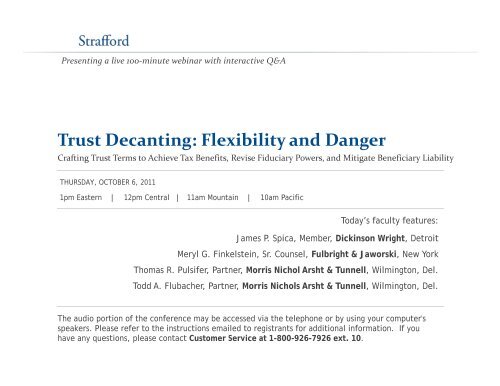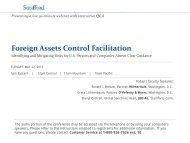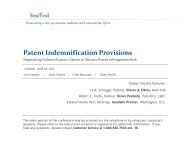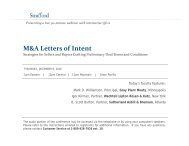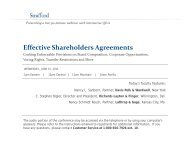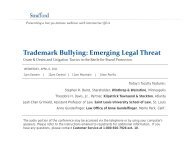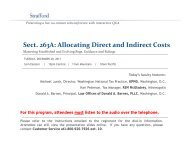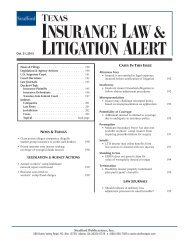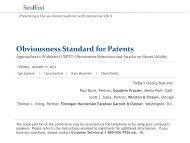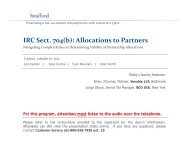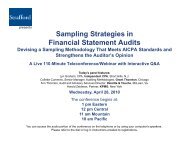Trust Decanting: Flexibility and Danger - Strafford
Trust Decanting: Flexibility and Danger - Strafford
Trust Decanting: Flexibility and Danger - Strafford
Create successful ePaper yourself
Turn your PDF publications into a flip-book with our unique Google optimized e-Paper software.
AppendixAncillary Outline: <strong>Decanting</strong> Tax Advantaged <strong>Trust</strong>s in MichiganPost Perpetuities Reform RAP Applicability for Property Subject to Michigan Law(1) Is the interest in question(“instant interest”) a nonvestedinterest 1 or a power of appointment?NoYesThe RAP isirrelevant tothe instantinterest’svalidity(2) Is the instant interest an interest in,or power over, real property?NoYes(3) Is the instant interest an interestin, or power over, (personal) propertyheld in a trust that was revocable on,or created after, May 28, 2008?NoYesMichigan’sUSRAP appliesto the instantinterest (90-year wait-<strong>and</strong>see)2Michigan’sUSRAP appliesto the instantinterest (90-year wait-<strong>and</strong>see)(4) Does the trust include assets that were held in a trust that wasirrevocable on September 25, 1985, which assets, in the meantime,(a) have continuously been held in trust <strong>and</strong> (b) have not beensubject to a general power of appointment? 3NoYesMichigan’sUSRAP appliesto the instantinterest (90-year wait-<strong>and</strong>see)________________________________________1 I.e., a contingent interest created by transfer.2 The adoption of the uniform statutory rule against perpetuities displaced the common law RAP inMichigan with respect to interests created on or after the USRAP’s 1988 effective date. See MICH.COMP. LAWS ANN. § 554.53. The common law perpetuities testing period is still relevant under theUSRAP, for an interest that must vest (if at all) within that period is, for that reason, valid under theUSRAP. Id. § 554.72. But an interest that may vest beyond the common law period cannot be invalidunder the USRAP before the relevant “wait-<strong>and</strong>-see” period elapses, a result that flatly contradicts thecommon law RAP. See id. Thus, one should not confuse the continued relevance of the common lawtesting period with continued application of the common law RAP itself: the USRAP makes use of theformer while displacing the latter.3 At this point, in order to keep the flowchart binary (i.e., “Yes” or “No,” but not both), we have to adopta sort of separate-share rule: if a trust comprises both (a) assets described in question (4) <strong>and</strong> (b) otherassets, the respective shares are treated as separate trusts for purposes of the flowchart. With respect tothe share that comprises assets described in question (4), the answer to question (4) is, “Yes”; with respectto the share that comprises other assets, the answer to question (4) is, “No.”Stafford Publications CLE Webinar App. 1
(9) Was either the first power or thesecond power a fiduciary power? 6NoYesMichigan’sUSRAP appliesto the instantinterest (360-year wait-<strong>and</strong>see)The RAP isirrelevant to theinstantinterest’svalidity________________________________________6 I.e., a power of appointment held by a trustee in a fiduciary capacity. See MICH. COMP. LAWS ANN.§ 554.92(b).DETROIT 99999-100 1220878v1Stafford Publications CLE Webinar App. 3
STRAFFORD PUBLICATIONS WEBINAR<strong>Trust</strong> <strong>Decanting</strong>: <strong>Flexibility</strong> <strong>and</strong> <strong>Danger</strong>Thursday, October 6, 1:00-2:30 PM (EDT)THE USES AND BENEFITS OF DECANTING ANDDECANTING’S CONCEPTUAL BASIS IN THE COMMON LAWAncillary Outline: <strong>Decanting</strong> Tax Advantaged <strong>Trust</strong>s in MichiganJames P. SpicaDickinson Wright PLLCDetroitI. IntroductionA. The General ProblemThe general problem with which we are concerned is fear <strong>and</strong> ambition for the longevityof "GST tax advantages," namely the status of assets that are "GST tax exempt," because"gr<strong>and</strong>fathered" under the Treasury's GST tax effective date regulations, or "GST-exclusionsheltered," having a "zero inclusion ratio," because of an allocation of the “GST exemption”described in Internal Revenue Code section 2631. For our purposes, it will not beoversimplifying to say that a “gr<strong>and</strong>fathered” trust is one that was irrevocable on September 25,1985. 1B. Significant Date Lines, Federal <strong>and</strong> StateThus the first analytically significant date line we encounter is September 25, 1985. Thesecond date line of significance is the effective date of rule against perpetuities (“RAP”) reform(or freedom). In Michigan, the timeline on which the vintage of a GST tax advantaged trustsubject to Michigan law is marked looks like this:→ ---9/25/85-----------------------5/28/08 (RAP) 2 --- →In Delaware, the timeline (for a GST tax advantaged trust subject to Delaware law) is:→ ---9/25/85----------1995 (RAP) 3 --- →1 See Treas. Reg. § 26.2601-1(b)(1)(i). A more accurate description would have to refer also tothe regulations’ transition rules for wills <strong>and</strong> revocable trusts executed before October 22, 1986 <strong>and</strong> forcertain cases involving mental incompetency. See id. § 26.2601-1(b)(2)-(3).2 See Personal Property <strong>Trust</strong> Perpetuities Act, 2008 Mich. Pub. Acts 148 (codified at MICH.COMP. LAWS ANN. §§ 554.91-.94).3 Delaware repealed its RAP for personal property held in trust in 1995. See H.B. 245, 138thGen. Assem., Reg. Sess. (Del. 1995), 70 Del. Laws 164.
45G r o u p T o u rSoutheasternItinerary — Making the grade … 63New Orleans style, LouisianaNational Corvette Museum, Kentucky 66WonderWorks, Florida <strong>and</strong> Tennessee 67Chattanooga, Tenn. 68Battleship North Carolina 70Hard Rock Park, South Carolina 71The Carolina Opry, South Carolina 72Dolphin Explorer <strong>and</strong> Marco Isl<strong>and</strong> 74Sea Excursions, FloridaMighty Eighth Air Force Museum 76<strong>and</strong> Museum of Aviation, GeorgiaVicksburg, Miss. 78Cookin’ Cajun Cooking School, Louisiana 80Savannah, Ga. 81Sloss Furnaces National Historic L<strong>and</strong>mark, Alabama 82948780Western U.S.A. & CanadaItinerary — Batoche — The Spirit of 83the Métis people, SaskatchewanBureau of Engraving <strong>and</strong> Printing 86Western Currency Facility, TexasLewisville, Texas 87The Journey Museum, South Dakota 88The Mammoth Site, South Dakota 89Arizona-Sonora Desert Museum 90USS Pampanito Submarine, California 92Fisherman’s Wharf Merchants <strong>and</strong> PIER 39, California 93Vancouver Attractions, British Columbia 94Grays Harbor Historical Seaport Authority, Washington 95Explora Science Center, New Mexico 9686Advertiser Index 9884 Fall 2008 > October/November/December
spray income among a group of beneficiaries, has a special powerof appointment. 8E. The Breadth <strong>and</strong> Narrowness of Our View“<strong>Decanting</strong>” is often described as involving the exercise only of fiduciary, special powersof appointment. 9 So, by treating decanting (as we shall) as involving also nonfiduciary powers,we are taking a broader view of the subject. But, by focusing on powers of appointment, we arenarrowing our view of the general problem described above, for decanting involves what is,decidedly, a proper subset of the occasions for fear or ambition for the longevity of GST taxadvantages. There are things one can do well that will increase such longevity, <strong>and</strong> things onecan do badly that will vitiate it, that do not involve powers of appointment at all.For example, in a situation in which the trustee has no discretion to make any distribution<strong>and</strong> no beneficiary has any power to appoint trust assets, on the one h<strong>and</strong> (1) a settlementagreement could extend the life of a gr<strong>and</strong>fathered trust for longer than the exercise of any powerof appointment (if there were any) could do 10 ; <strong>and</strong>, on the other h<strong>and</strong>, (2) a trust modified onconsents could (a) forfeit gr<strong>and</strong>fathered status by shifting a beneficial interest to a youngergeneration 11 or (b) waste an allocated GST exemption by causing the trust's assets to beincludable in the transfer tax base of a current beneficiary.But we shall keep the focus on special powers of appointment as the peculiar province oftrust decanting―we shall confine ourselves, that is, to occasions for fear or ambition for thelongevity of GST tax advantages that have particularly to do with special powers of appointment.II. Case 1A. The GST Tax Effective Date Regulations’ Very Own RAPThe Treasury’s GST tax effective date regulations subject the tax advantage ofgr<strong>and</strong>fathered status to a RAP of their own (“Regulatory RAP”), <strong>and</strong> the Regulatory RAP isexpressly liable to be fouled by the exercise of a special power of appointment. 12 Theregulations generally exempt from GST tax any generation skipping transfer under a trust thatwas irrevocable on September 25, 1985 to the extent assets are not added to the trust after thatdate. 13 There are elaborate rules about what constitutes an “addition” to the assets of agr<strong>and</strong>fathered trust for this purpose, including a rule that if a nonfiduciary, nongeneral power ofappointment is exercised in such a way that the vesting, absolute ownership or power ofalienation of an interest in assets of the gr<strong>and</strong>fathered trust may be postponed or suspendedbeyond the Regulatory RAP period, the assets subject to the exercise may lose exempt status,thence forward being fully subject to GST tax. 148 JESSE DUKEMINIER ET AL., WILLS, TRUSTS, AND ESTATES 591 (7th ed. 2005).9 See, e.g., William R. Culp, Jr. & Briani Bennett Mellen, <strong>Trust</strong> <strong>Decanting</strong>: An Overview <strong>and</strong>Introduction to Creative Planning Opportunities, 45 REAL PROP. TR. & EST. L.J. 1, 1 (Spring 2010).10 See Treas. Reg. § 26.2601-1(b)(4)(i)(B).11 See id. § 26.2601-1(b)(4)(i)(D).12 See id. §§ 26.2601-1(b)(1)(v)(B); .2601-1(b)(4)(i)(A).13 See id. § 26.2601-1(b)(1)(i).14 See id. § 26.2601-1(b)(1)(v)(B). The precise effect of loss of “gr<strong>and</strong>fathered” status is notspelled out in the effective date regulations, <strong>and</strong> the Service has taken inconsistent positions in privateletter rulings. See generally Culp & Mellen, supra note 9, at 22.Stafford Publications CLE Webinar 1-3
That is the reason for section 1(e) of the USRAP as amended in 1990 by the NationalConference of Commissioners on Uniform State Laws. 20 Michigan, which failed to enactsection 1(e) when it originally adopted the USRAP, adopted a version of the provision, tailoredfor what the Personal Property <strong>Trust</strong> Perpetuities Act of 2008 (“2008 Act”) defines as “specialappointee trusts,” 21 when it adopted the 2008 Act. 22 Michigan’s version of section 1(e) appearsin Michigan USRAP section 2(5):(5) If, in measuring a period from the creation of a trust or otherproperty arrangement that was irrevocable on September 25, 1985,language in an instrument governing the effect of an exercise of apower of appointment over property exempt from federalgeneration skipping transfer tax (a) seeks to disallow the vesting ortermination of any interest or trust beyond, (b) seeks to postponethe vesting or termination of any interest or trust until, or (c) seeksto operate in effect in any similar fashion upon, the later of (i) theexpiration of a period of time ending with, or not exceeding 21years after, the death of the survivor of specified lives in being atthe creation of the trust or other property arrangement or (ii) theexpiration of a period of time that exceeds or might exceed 21years after the death of the survivor of lives in being at the creationof the trust or other property arrangement, that language isinoperative to the extent it produces a period of time that exceeds21 years after the death of the survivor of the specified lives. 23Now, Michigan has not had a rule against suspension of absolute ownership or the powerof alienation with respect to l<strong>and</strong> since 1949 <strong>and</strong> has never had a rule against suspension ofabsolute ownership or the power of alienation with respect to personal property. 24 But theaddition of section 2(5) to Michigan’s USRAP provided a substantial statutory safeguard against20 Dukeminier, supra note 17, at 187-94.21 See MICH. COMP. LAWS ANN. § 554.94 as amended by 2011 Mich. Pub. Acts 12.22 Compare Unif. Statutory Rule Against Perpetuities § 1(e) (amended 1990), 8B U.L.A. 237(2001) with MICH. COMP. LAWS ANN. § 554.72(5) as amended by 2008 Mich. Pub. Acts 149 (effectiveMay 28, 2008). See James P. Spica, Rule Against Perpetuities Repeal in Michigan, MICH. PROB. & EST.PLAN. J., Summer 2008, at 10.23 See MICH. COMP. LAWS ANN. § 554.72(5).24 The common law RAP was partly superseded in Michigan, from 1847 to 1949, by statutoryprovisions limiting suspension of the power of alienation. See Lantis v. Cook, 69 N.W.2d 849 (Mich.1955). Those provisions applied only to real property. Rodney v. Stotz, 273 N.W. 404 (Mich. 1937).Later amendments repealed the provisions <strong>and</strong> restored the applicability of the common law RAP to realproperty, “thereby making uniform the rule as to perpetuities applicable to real <strong>and</strong> personal property.”Public Act. No. 38, 1948 Mich. Pub. Acts 38 (effective September 23, 1949) (codified as MICH. COMP.LAWS ANN. § 554.51). And there was no rule against suspension of the power of alienation at commonlaw. See John C. Gray, The Rule Against Perpetuities (4th ed. 1942). Of course, the rule againstsuspension of the power of alienation has to be distinguished from prohibitions against direct restraints onalienation that may be ineffective per se, without regard to their duration. See, e.g., Stephen E. Greer, TheDelaware Tax Trap <strong>and</strong> the Abolition of the Rule Against Perpetuities, 28 EST. PLAN. 68, 70 (2001).Stafford Publications CLE Webinar 1-5
inadvertent loss of GST tax exempt status with respect to powers of appointment over the assetsof gr<strong>and</strong>fathered trusts. Given that the maximum period for which exercise of a nongeneralpower can postpone vesting is measured from the time the power was created, 25 section 2(5) iscompetent to rescue situations involving exercises of nongeneral powers subject to manycommon types of perpetuities saving clauses.C. Fear: Wait-<strong>and</strong>-See Periods <strong>and</strong> PerpetuityIt is important to note, however, that section 2(5) does not make Michigan’s USRAPfoolproof with respect to gr<strong>and</strong>fathered generation skipping trusts, for the scope of USRAPsection 1(e) itself is far from clear. 26 We do not know, for instance, how section 2(5) would beapplied if an instrument containing no saving clause at all should exercise a nongeneral powerover a gr<strong>and</strong>fathered trust so as clearly to violate the common law RAP with respect to onevesting contingency (“C1”), but satisfy the common law rule with respect to an alternativecontingency (“C2”). In that case, the interest is valid under the common law rule if it vests onC2, by virtue the so-called “alternative contingencies doctrine,” <strong>and</strong> the interest is valid if it vestson C1 within ninety years, by virtue of the USRAP’s ninety-year wait-<strong>and</strong>-see period. Thus, theUSRAP is liable to provide a statutory longer-of-the-two provision in this case. 27The 2008 Act does not apply to personal property the transfer tax status of which is stillaffected by the property’s having been held in a trust that was gr<strong>and</strong>fathered under the effectivedate regulations. 28 (The RAP-applicability flowchart in the Appendix schematically locates“special appointee trusts” among other circumstances in which Michigan’s USRAP applies toproperty subject to Michigan law after the 2008 Act’s effective date.) So, the exercise of aspecial power of appointment over such property in favor of a trust that became irrevocable after,May 28, 2008 will not complicate the analysis under the Treasury regulations. But practitionersdeploying alternative vesting contingencies would do well either (1) to force interests created bythe exercise to vest before the ninetieth anniversary of the gr<strong>and</strong>fathered trust’s creation or (2) tosatisfy the common law RAP.D. Ambition: Extraneous Measuring LivesThe effective date regulations preclude a tax-advantaged perpetuity, but the RegulatoryRAP alternative of the common law testing period offers some scope for longevity planning:“extending beyond any life in being at the date of the creation of the trust plus a period of 21years . . . .” 29 We should imagine a pool of measuring lives comprising people who bid fair toachieve longevity, all of whom were born on (or, perhaps, up to three years before) the date onwhich the gr<strong>and</strong>fathered trust became irrevocable . . . .25 See MICH. COMP. LAWS ANN. § 556.124.26 See Dukeminier, supra note 17, at 199-201.27 See id.28 See MICH. COMP. LAWS ANN. § 554.94 as amended by 2011 Mich. Pub. Acts 12.29 Treas. Reg. § 26.2601-1(b)(1)(v)(B)(2) (emphasis added).Stafford Publications CLE Webinar 1-6
III. Case 2A. Fiduciary Special Powers Subject to the Regulatory RAPThe effective date regulations (1) subject fiduciary, special powers of appointment to theRegulatory RAP, (2) raise exactly the same fears for longevity discussed above <strong>and</strong> (3) offerexactly the same scope for ambition (longevity planning) provided the terms of the gr<strong>and</strong>fatheredtrust or state law at the time the gr<strong>and</strong>fathered trust became irrevocable authorized thedistribution to a new trust (or retention of the principal in the continuing trust) without theconsent or approval of any beneficiary or court. 30B. Regulation Section 26.2601-1(b)(4)(i)(D)There is no scope for ambition (longevity planning) at all in the regulations’ alternative“safe harbor” for the exercise of a fiduciary, special power of appointment (which must be anexercise that does not shift a beneficial interest in the trust to a younger generation ofbeneficiaries), for that alternative requires that the exercise not “extend the time for vesting ofany beneficial interest in the trust beyond the period provided for in the original trust.” 31C. Common Law <strong>Decanting</strong>The Restatement (Second) <strong>and</strong> Tentative Draft No. 5 of the Restatement (Third) bothsupport the proposition that a trustee’s power to make discretionary distributions entails thepower to make distributions in trust for permissible distributees unless the trust instrument thatcreated the discretionary power manifests a contrary intent. 32 There is (as far as the authorknows) no decided case binding as precedent on Michigan judges that st<strong>and</strong>s for thatproposition. 33 But the absence of local precedent has not prevented states considering decantinglegislation from asserting that their decanting statutes are at least partly declaratory of commonlaw applicable prior to enactment. 34 Indeed, a legislative decanting regime for Michigan, whichhas been proposed by Greenleaf <strong>Trust</strong> <strong>and</strong> is currently before committees of the <strong>Trust</strong> CounselCommittee of the Michigan Bankers Association <strong>and</strong> the Council of the Probate <strong>and</strong> EstatePlanning Section of the State Bar, purports to be partly declarative.In any case, unless the instrument governing the gr<strong>and</strong>fathered trust expressly authorizesthe trustee to decant (that is, to make distributions to permissible distributees in trust), <strong>and</strong>30 See id. § 26.2601-1(b)(4)(i)(A).31 Id. § 26.2601-1(b)(4)(i)(D).32 See RESTATEMENT (SECOND) OF PROP.: DONATIVE TRANSFERS § 19.3 cmt. a illus. 2 (1986);RESTATEMENT (THIRD) OF PROP.: WILLS & OTHER DONATIVE TRANSFERS § 17.1 (Tentative Draft No. 5,2006).33 In Paine v. Kaufman (In re Estate of Resiman), 702 N.W.2d 658 (Mich. Ct. App. 2005), theMichigan Court of Appeals adduced the foundational provisions of the Restatement (Second), but thecase before the court involved a nonfiduciary power <strong>and</strong> the instrument creating the power expresslyauthorized appointment in trust.34 See WILLIAM J. MCGRAW III, OHIO STATE BAR ASSOCIATION, REPORT OF THE ESTATEPLANNING, TRUST AND PROBATE LAW SECTION 66-67 (n.d.), http://www.ohiobar.org/General%20-Resources/pubs/councilfiles/EstPlanComReport.pdf (explaining a proposal to enact new section 5808.18of the Ohio <strong>Trust</strong> Code authorizing decanting).Stafford Publications CLE Webinar 1-7
provided the instrument does not rule out the trustee’s decanting, 35 the scope for longevityplanning in Case 2 depends on the plausibility of the claim that, as indicated in the Restatements,the common law authorizes the trustee to make distributions in trust for the benefit ofpermissible distributees.IV. Case 3A. The Irrelevance of the Effective Date RegulationsWith Case 3, we turn our attention to GST-exclusion sheltered assets (assets having an“inclusion ratio” of zero because of an allocation of the “GST exemption” described in Codesection 2631). There is absolutely nothing in the Treasury’s effective date regulations that hasanything to do with the GST exemption. 36B. The Stultification of “Negative Implication”It is true that the Service regularly rules that there is no threat to GST-exclusion-shelteredstatus in circumstances in which there would be no threat to GST-tax-exempt status. 37 It is alsotrue that only an imbecile would reason as follows:(1) If John has leapt three feet vertically, he has leapt one foot vertically;(2) John has not leapt three feet vertically;Therefore,(3) John has not leapt one foot vertically.As this example (of the logical fallacy of “denying the antecedent”) suggests, to say that there isno threat to GST-exclusion-sheltered status in circumstances in which there would be no threat toGST-tax-exempt status (even if it is true), says absolutely nothing about the case in which therewould be a threat to GST-tax-exempt status (if GST-tax-exempt status were relevant). TheServices’ penchant for adverting to the effective date regulations apropos of situations to whichthey do not apply lends no credence whatsoever to the idea that the Regulatory RAP applies toexercises of special powers of appointment over assets to which GST exemption has beenallocated.C. The Abortive Section 26.2652-1(a)(4)The Treasury did once propose to apply the Regulatory RAP in just that way, that is toexercises of special powers of appointment over assets to which GST exemption has been35 For the proposition that the instrument creating a power of appointment can limit the manner ofthe power’s exercise in any particular, see MICH. COMP. LAWS ANN. §§ 556.112(c) (defining ‘power ofappointment’ as “a power . . . which enables the donee of the power to designate, within any limits thatmay be prescribed, the transferees of the property [subject to the power]”); .115(2) (requiring that anexercise comply “with the requirements, if any, of the creating instrument as to the manner, time <strong>and</strong>conditions of the exercise”). See also Hannan v. Slush, 5 F.2d 718, 722 (E.D. Mich. 1925) (requiring thatthe power be exercised in the mode prescribed by donor).36 See Treas. Reg. § 26.2601-1(b)(4). See also, e.g., Culp & Mellen, supra note 9, at 23.37 See, e.g., I.R.S. Priv. Ltr. Rul. 200743028 (May 29, 2007); I.R.S. Priv. Ltr. Rul. 200919008(May 8, 2009).Stafford Publications CLE Webinar 1-8
allocated. Prior to the adoption of the final GST tax regulations, the proposed regulations undersection 2652 provided:The exercise of a power of appointment that is not a general powerof appointment (as defined in section 2041(b)) is treated as atransfer subject to Federal estate or gift tax by the holder of thepower if the power is exercised in a manner that may postpone orsuspend the vesting, absolute ownership, or power of alienation ofan interest in property for a period, measured from the date ofcreation of the trust, extending beyond any specified life in beingat the date of creation of the trust plus a period of 21 years plus, ifnecessary, a reasonable period of gestation (perpetuities period).For purposes of this paragraph (a)(4), the exercise of a power ofappointment that validly postpones or suspends the vesting,absolute ownership or power of alienation of an interest in propertyfor a term of years that will not exceed 90 years (measured fromthe date of creation of the trust) is not an exercise that may extendbeyond the perpetuities period. 38But a subsequent amendment to the proposed regulation deleted this provision 39 leaving no traceof the Treasury’s faint-hearted attempt to extend the Regulatory RAP beyond the effective dateprovisions.D. Ambition: Access to Perpetuity (<strong>and</strong> Herein of the Difference Between<strong>Decanting</strong> <strong>and</strong> Mergers)The upshot is that there is no GST tax prohibition against extending, by the exercise of aspecial power of appointment, the period during which GST-exemption-sheltered assets will beheld in trust. 40 With respect to personal property, in Michigan, that means access to perpetuity(or, at least, the 360-year “wait-<strong>and</strong>-see” period provided in the 2008 Act’s anti-Delaware-taxtrapprovision), for (except with regard to “special appointee trusts”) the 2008 Act applies tononvested interests in personal property held in any trust revocable on, or created after, MAY 28,2008. 41 So, if assets of a pre-May 28, 2008 trust to which GST exemption was allocated areappointed by means of a special power to a post-May 28, 2008 trust, the assets’ GST-exemptionshelteredstatus may last either forever, or if the power thus exercised was created by anotherpower under the circumstances described in the 2008 Act’s anti-Delaware-tax-trap provision,then for 360 years from the date the earlier power was created. 42The ability to appoint into the new perpetuities regime by the creation of a new trustraises what may be one important difference, for purposes of Cases 3 <strong>and</strong> 4, between decanting38 Prop. Treas. Reg. § 26.2652-1(a)(4), 61 Fed. Reg. 29654 (June 12, 1996) (subsequentlyamended by T.D. 8720, 1997-1 C.B. 187). Cf Treas. Reg. §§ 26.2601-1(b)(1)(v)(B); .2601-1(b)(4)(i)(A).39 T.D. 8720, 1997-1 C.B. 187.40 See Culp & Mellen, supra note 9, at 23; CAROL A. HARRINGTON ET AL., GENERATION-SKIPPING TRANSFER TAX: ANALYSIS WITH FORMS 2.02[1] (2d ed. 2001).41 See MICH. COMP. LAWS ANN. § 554.94. As to the exception for “special appointee trusts,” seesupra note 28 <strong>and</strong> accompanying text.42 See MICH. COMP. LAWS ANN. § 554.93.Stafford Publications CLE Webinar 1-9
the assets of an old trust into a new one, on the one h<strong>and</strong>, <strong>and</strong> the merger of an old trust with anew one, on the other: the Michigan <strong>Trust</strong> Code’s merger provision may require the segregationof perpetuities parcels, depending how the phrase ‘the rule against perpetuities speaks fromdifferent dates with reference to the trusts’ is interpreted. 43E. Fear: Absence of Authority to Appoint in <strong>Trust</strong>If the instrument creating the power over the GST-exemption-sheltered assets expresslyprovides that the holder may appoint in trust for a permissible appointee, the holder’s power todecant is clear. 44 The Restatements (Second) <strong>and</strong> (Third) st<strong>and</strong> for the proposition that unless theinstrument creating a special power of appointment manifests a contrary intent, the holder ofsuch a power may exercise the power by creating a trust for the benefit of one or morepermissible appointees. 45 But if the instrument creating the power rules out appointments intrust, the power cannot provide access to perpetuity. 46F. Fear: The Delaware Tax TrapThe 2008 Act’s anti-Delaware-tax-trap provision prevents appointment by means of aspecial power to a post-May 28, 2008 trust subject to Michigan law from springing the Delawaretax trap. 47 It is still possible under the 2008 Act to spring the Delaware tax trap by creating apresently exercisable general power of appointment, 48 but the risk of someone’s doing thatinadvertently in this setting is practically nil, for the objective of preserving the life of GSTexemption-shelteredstatus precludes the creation of a general power of any kind.V. Case 4Like the provisions on nonfiduciary, special powers of appointment, the effective dateregulations’ provisions on fiduciary, special powers only apply to gr<strong>and</strong>fathered trusts. 49 So,unless the trust instrument expresses an intent to the contrary, 50 a trustee with a special power ofappointment may entertain exactly the same ambition for the longevity of GST-exclusionshelteredstatus as a beneficiary holding such a power may entertain. Furthermore, unless thetrustee is also a beneficiary of the trust in question, the Delaware tax trap will be irrelevant. 5143 See MICH. COMP. LAWS ANN. § 700.7417(2) (emphasis added).44 See Paine v. Kaufman (In re Estate of Resiman), 702 N.W.2d 658 (Mich. Ct. App. 2005).45 See RESTATEMENT (SECOND) OF PROP.: DONATIVE TRANSFERS § 19.3 (n.b., cmt. a, illus. 2)(1986); RESTATEMENT (THIRD) OF PROP.: WILLS & OTHER DONATIVE TRANSFERS § 19.14 (n.b., cmt. d)(Tentative Draft No. 5, 2006).46 See supra note 35.47 See generally, James P. Spica, A Trap for the Wary: Delaware’s Anti-Delaware-Tax-TrapStatute Is Too Clever by Half (of Infinity), 43 REAL PROP. TR. & EST. L. J. 673, 677-681 (2009).48 See id. at n. 49.49 See Treas. Reg. § 26.2601-1(b)(4).50 See supra note 35; notes 44-46 <strong>and</strong> accompanying text.51 See Spica, supra note 47, at 675.Stafford Publications CLE Webinar 1-10
VI. Cases 5 <strong>and</strong> 6Without regard to any transfer from one trust to another, GST-exclusion-sheltered statusmay last forever in Cases 5 <strong>and</strong> 6, at least for trusts to which GST exemption is allocated beforethe effective date (if ever there is one) of the proposal in the President’s Fiscal Year 2012 Budgetthat property should be GST-exclusion sheltered only for ninety years from the date the GSTexclusion is allocated. 52 As proposed, this ninety-year limitation would apply only to allocationsmade after the date of enactment. 53VII. ConclusionThe fear in Cases 1 <strong>and</strong> 2 is fear of an alien power, namely the Regulatory RAP. Becauseof that alien power, the height of ambition, in those cases, is a pool of measuring lives. InCases 3 <strong>and</strong> 4, despite the Service’s posturing in private letter rulings, there is nothing to fearfrom the Regulatory RAP, very little to fear from the Delaware tax trap, <strong>and</strong> much to hope fromthe access to perpetuity provided by the 2008 Act.For the nonce, Cases 5 <strong>and</strong> 6 are like Cases 3 <strong>and</strong> 4, without the necessity of anymovement (without the necessity, that is, of appointing assets from one trust to another) in orderto achieve the perpetuity of GST-exemption-sheltered status. The future, however, holds thepossibility of enactment of the proposal in the President’s Fiscal Year 2012 Budget prospectivelyto impose a unitary GST-exemption-shelter “shelf life” on all allocations of the GSTexemption. 54DETROIT 99999-100 1219535v152 DEPT. OF THE TREASURY, GENERAL EXPLANATIONS OF THE ADMINISTRATION’S FISCAL YEAR2012 REVENUE PROPOSALS 129-30 (2011).53 See id. at 130.54 See supra notes 52-53 <strong>and</strong> accompanying text.Stafford Publications CLE Webinar 1-11
<strong>Strafford</strong> Publications WebinarOctober 6, 2011THE DELAWARE DECANTING STATUTEThomas R. PulsiferMorris Nichols Arsht & Tunnell LLP1201 North Market StreetP. O. Box 1347Wilmington, DE 19899-1347Telephone: (302) 351-9226Facsimile: (302) 425-4682tpulsifer@mnat.comwww.mnat.com
Table of ContentsPageI. Introduction..........................................................................................................................1A. The Concept............................................................................................................ 1B. Terminology............................................................................................................ 2II. The Statute ...........................................................................................................................2A. Overview of How the Statute Works...................................................................... 2B. Statutory Details...................................................................................................... 3III. Mechanics ............................................................................................................................4A. How Is “<strong>Decanting</strong>” Done ...................................................................................... 4B. When Is <strong>Decanting</strong> Permitted ................................................................................. 5C. Protecting the <strong>Trust</strong>ee ............................................................................................. 5D. Ascertainable St<strong>and</strong>ard ........................................................................................... 6E. Governing Law Considerations .............................................................................. 6IV. Possible Uses of <strong>Decanting</strong> Statute .....................................................................................7A. Alter Administrative Provisions ............................................................................. 7B. Clarify Ambiguous Provisions................................................................................ 8C. Extend the Life of <strong>Trust</strong>.......................................................................................... 8D. Create Subtrusts ...................................................................................................... 9E. Avoid State Income Tax ......................................................................................... 9F. Grant Powers of Appointment .............................................................................. 10V. Generation-Skipping Transfer Tax Considerations ...........................................................10A. Treasury Reg. § 26.2601-1(b)(4)(i)(D)................................................................. 10
The Delaware <strong>Decanting</strong> StatuteI. IntroductionA. The ConceptAt least ten states (Alaska, Arizona, Delaware, Florida, Nevada, New Hampshire,New York, North Carolina, South Dakota <strong>and</strong> Tennessee) have enacted so-called “decantingstatutes.” The statutes vary in their details but the fundamental concept behind each isessentially the same in that all of the statutes permit trustees authorized to make outrightdistributions from a trust to instead make such distributions in further trust. The concept issimple but the implications <strong>and</strong> opportunities are immense <strong>and</strong> complex. This outline focusesentirely on Delaware’s decanting statute. Delaware’s decanting statute (12 Del. C. § 3528)permits trustees empowered to distribute trust principal outright to, or among, trust beneficiaries,whether the power is discretionary or exercisable pursuant to an enforceable distributionst<strong>and</strong>ard, to instead distribute trust assets to a different trust for the benefit of one or more of thebeneficiaries to whom the trustee could have made an outright distribution. The practicalopportunity (<strong>and</strong> customary use) afforded by this statute is to permit the trustee to make adistribution from a trust governed by an outdated trust instrument to a new trust governed by amodern trust instrument held upon beneficial terms substantially identical to the beneficial termsof the old trust. Thus, without in any way altering the trust’s beneficial terms, a trust “trapped”in an old document can be “decanted” to a new vessel incorporating modern investmentprovisions, updated administrative provisions <strong>and</strong> other useful provisions without the necessityof a court-supervised reformation. However, this customary use of the decanting statute is nomore than the tip of the iceberg, as the possible uses of the decanting statute are as varied <strong>and</strong>
numerous as the ideas that spring from the minds of thoughtful <strong>and</strong> creative trustees <strong>and</strong> theiradvisors.B. TerminologyFor convenience <strong>and</strong> ease of underst<strong>and</strong>ing, the term “first governing instrument”is used throughout this outline to refer to an existing trust instrument, including a trustagreement, Will, court order or any other document that creates a trust (referred to herein as the“first trust”) from which assets may be distributed in further trust pursuant to the decantingstatute. The term “second governing instrument” is intended to refer to whatever documentcreated the trust (referred to herein as the “second trust”) to which assets from the first trust maybe distributed pursuant to the decanting statute. The second governing instrument might be anewly minted declaration of trust made by the trustee; could be a preexisting trust instrument thatcreated a trust already in existence prior to the decanting transaction or could be the samedocument, that exercises the trustee’s decanting power.II.The StatuteA. Overview of How the Statute WorksIn brief, the statute simply enables the trustee to make principal distributions infurther trust when <strong>and</strong> to the extent that the trustee is empowered by the first governinginstrument to make principal distributions outright. The statute does not address the possibilityof decanting income so income may not be decanted as such. Of course, if the trustee isempowered to accumulate income <strong>and</strong> add it to principal, then, as a practical matter, income alsomay be decanted. Furthermore, if the first governing instrument requires income to bedistributed, a trustee empowered to distribute principal outright could, subject to a special rule- 2 -
for marital deduction trusts, decant to a second trust in which the income beneficiaries of the firsttrust are no longer eligible to receive income.B. Statutory DetailsThe detailed rules of the statute work essentially like the rules of a board game.The trustee is empowered by the statute to craft the second governing instrument in whatevermanner seems best to the trustee (abiding by the fiduciary duties, st<strong>and</strong>ard of care <strong>and</strong>distributing st<strong>and</strong>ards imposed upon the trustee by the first governing instrument) so long as thetrustee does not violate any of the rules imposed by the statute as limitations upon the trustee’sdecanting power. One such rule is that the second trust must have only beneficiaries who wereeligible to receive principal distributions from the first trust. So the trustee may not add newbeneficiaries. However, the trustee may grant one or more general or limited powers ofappointment to one or more beneficiaries of the first trust who were eligible to receivedistributions from the first trust. As a result, the trustee <strong>and</strong> first trust beneficiaries collectivelymay fairly be said to possess the ability (without adverse transfer tax consequences) to cause thebenefits of first trust property to be enjoyed by persons who were not beneficiaries of the firsttrust. Another of the statutory rules is that the trustee may provide in the second governinginstrument that, at a time or upon an event specified in the second governing instrument, theassets of the second trust shall thereafter be held for the benefit of the beneficiaries of the firsttrust upon terms <strong>and</strong> conditions concerning the nature <strong>and</strong> extent of each such beneficiary’sinterest that are substantially identical to the first governing instrument’s terms <strong>and</strong> conditionsconcerning such beneficial interests. This means, among other things, that all of the provisionsof the first governing instrument regarding beneficiaries other than those currently eligible toreceive distributions (such as those who may be eligible to receive distributions in the future <strong>and</strong>- 3 -
emaindermen) may be preserved in the second governing instrument. However, the trustee maynot add new current or non-current beneficiaries nor accelerate or otherwise alter the interests ofthe various non-current beneficiaries identified in the first governing instrument. So, forexample, if the trustee is empowered by the first governing instrument to sprinkle distributionsamong the descendants of the settlor <strong>and</strong> the first governing instrument provides that theremaining trust assets pass to charity upon the death of the settlor’s last living descendant, thetrustee could create a second trust for the benefit of some (but less than all) of the settlor’sdescendants but could not provide for a distribution from the second trust to charity sooner thanwas permitted by the first governing trust (meaning no charity could take anything from thesecond trust so long as any descendant of the settlor remained living). The remaining rules arerules that prevent the trustee from (a) decanting from a revocable trust; (b) delaying the time thatinterests in a so-called “minor’s trust” vest <strong>and</strong> become distributable; (c) decanting if the firstgoverning instrument expressly forbids decanting; (d) reducing an income interest in a trust forwhich a marital deduction has been taken for federal estate or gift tax purposes; <strong>and</strong> (e) decantingproperty subject to a current withdrawal right held by a trust beneficiary who is the onlybeneficiary eligible for current distributions.III.MechanicsA. How Is “<strong>Decanting</strong>” DoneThe Delaware statute provides that the decanting transaction whereby trust assetsare distributed from one trust to another trust must be accomplished by an instrument in writing,signed <strong>and</strong> acknowledged by the trustee <strong>and</strong> filed with the records of the trust. In this instance,the statute seems plainly to refer to the records of the first trust but it seems evident the trustee(or the two trustees if the second trust’s trustee is a different trustee) for both trusts ought to keep- 4 -
a copy of this written instrument among the trust records.The statute mentions“acknowledgment,” which means that the written instrument must be notarized. Beyond thesefew formalities, the trustee is left to the trustee’s own devices to determine how best to arrangethe mechanics of decanting transactions.B. When Is <strong>Decanting</strong> PermittedUnless the first governing instrument expressly prohibits decanting, a trustee may,under Delaware law, decant whenever the trustee has authority to make outright principaldistributions whether or not the trustee’s distribution power is limited by an ascertainablest<strong>and</strong>ard but only to the extent that trust principal is currently distributable. So, for example, ifthe trustee may distribute up to 5% of principal annually for the education of beneficiaries, thetrustee may only decant to that extent <strong>and</strong> for that purpose.C. Protecting the <strong>Trust</strong>eeAs a practical matter, decanting is far more likely to be employed <strong>and</strong> in a farmore creative <strong>and</strong> potentially beneficial manner in cases where the trustee is adequatelyprotected from potential liability for having engaged in the decanting transaction. Therefore,decanting works best when the trustee is fully protected from liability for having undertaken thedecanting transaction. Under Delaware law, adult trust beneficiaries may release a trustee fromliability for engaging in a decanting transaction. 12 Del. C. § 3588. Furthermore, the releases ofthe trust’s adult beneficiaries <strong>and</strong> presumptive remaindermen generally will bind the trust’sminor <strong>and</strong> unborn beneficiaries <strong>and</strong> contingent remaindermen. 12 Del. C. § 3547. Notsurprisingly, trustees tend to be far more receptive to decanting opportunities when all of thecurrent adult <strong>and</strong> presumptive remaindermen beneficiaries are prepared to consent to thetransaction in a fashion that binds the other trust beneficiaries.- 5 -
D. Ascertainable St<strong>and</strong>ardSome state’s decanting statutes appear to permit decanting only when the trusteeis permitted to distribute trust principal in the trustee’s sole discretion <strong>and</strong> not pursuant to anascertainable st<strong>and</strong>ard. The Delaware decanting statute, however, permits decanting in everycase where the trustee is empowered to distribute principal without regard to whether thetrustee’s distribution power is constrained by an ascertainable st<strong>and</strong>ard. Of course, if anascertainable st<strong>and</strong>ard is imposed upon the trustee, the trustee must abide by that st<strong>and</strong>ard whendecanting just as would be the case if the trustee were making an outright distribution from thetrust.E. Governing Law ConsiderationsThe Delaware decanting statute provides that the use of the statute to decant shallbe considered the exercise of a power of appointment (other than a power to appoint to thepowerholder, the powerholder’s creditors, the powerholder’s estate, or the creditors of thepowerholder’s estate) <strong>and</strong> shall be subject to the provisions of Chapter 5 of Title 25 of theDelaware Code concerning the time at which the permissible period of the rule againstperpetuities begins <strong>and</strong> the law which determines the permissible period of the rule againstperpetuities. Chapter 5 of Title 25, together with the Delaware Chancery Court’s opinion inWilmington <strong>Trust</strong> Company v. Wilmington <strong>Trust</strong> Company (26 Del. Ch. 397, 1942), makes clearthat the validity of the exercise of a limited power of appointment (<strong>and</strong>, by virtue of the crossreference in the decanting statute, the validity of a decanting transaction) is governed byDelaware law whenever the trust has its situs in Delaware at the time that the power is exercised.This result is confirmed by the express provisions of 12 Del. C. § 3528(f) which was added to thestatute by a 2011 amendment. Accordingly, the trustee of a trust initially created outside- 6 -
Delaware <strong>and</strong> governed initially by the law of some other jurisdiction, could, as a matter ofDelaware law, decant pursuant to the Delaware decanting statute if the trust’s situs were movedto Delaware. Thus, a trustee should be able to use the decanting statute whenever the trust isadministered in Delaware even if some other jurisdiction’s laws govern the trust’s validity,construction <strong>and</strong> administration. It should be noted, however, that in most cases Delaware lawwould govern matters of administration for so long as the trust’s situs is Delaware. See 12 Del.C. § 3332. Furthermore, Delaware’s release statute (12 Del. C. § 3588) <strong>and</strong> virtualrepresentation statute (12 Del. C. § 3547) might not be available unless Delaware law governsadministration meaning that the utility of the decanting statute might be severely compromisedgiven the underst<strong>and</strong>able reluctance of trustees to decant without some assurance that thebeneficiaries will not sue the trustee if the decanting turns out to produce some adverseconsequence from the point of view of one or more of the beneficiaries.IV.Possible Uses of <strong>Decanting</strong> StatuteA. Alter Administrative ProvisionsProbably the most obvious <strong>and</strong> common use of decanting statutes in Delaware <strong>and</strong>elsewhere is to improve the trust’s administrative provisions without altering beneficial interestsin any manner. The statute can be used in Delaware, for example, to (i) add a direction orconsent investment or distribution adviser to invest or participate in the investment of some or allof the trust assets or direct or participate in distribution decisions; (ii) modernize antiquatedprovisions; (iii) incorporate modern or more flexible investment authority; (iv) enumerateexpress powers useful or perhaps essential to the trustee; (v) add other advisers; (vi) add trustprotectors or similar fiduciaries having special roles or powers such as the ability to oversee orremove trustees or other fiduciaries; (vii) revise provisions that otherwise might cause potential- 7 -
tax problems; <strong>and</strong> (viii) revise st<strong>and</strong>ards of care or liability as appropriate to increase trustflexibility.B. Clarify Ambiguous ProvisionsAmbiguous provisions <strong>and</strong> other inartful provisions may be addressed bydecanting to a second trust governed by a second governing instrument identical to the firstgoverning instrument except to the extent necessary to resolve the ambiguity or otherproblematic provisions appearing in the first governing instrument. However, in such cases, ifthe resolution of an ambiguity even arguably alters beneficial interests, or could in anycircumstance have the effect of altering beneficial interests, a prudent trustee will not generallyengage in the decanting transaction unless the trustee is protected by appropriate releases bindingall of the current <strong>and</strong> potential trust beneficiaries <strong>and</strong> the trustee, in consultation with competentadvisers, is satisfied that the resolution does not raise material tax considerations as there aremany situations in which altering ambiguous provisions could create adverse income, gift orgeneration-skipping transfer tax consequences.C. Extend the Life of <strong>Trust</strong>As was mentioned in III.E above, the Delaware decanting statute provides that theuse of the statute to decant shall be considered the exercise of a limited power of appointment<strong>and</strong> shall be subject to the provisions of Chapter 5 of Title 25 of the Delaware Code covering thetime at which the permissible period of the rule against perpetuities begins. For the reasonsexplained in III.E, Delaware law will govern this issue if the trust is located in Delaware at thetime of the decanting <strong>and</strong> under a unique provision of Delaware law it is possible to commence anew perpetuities period by virtue of the exercise of a limited power of appointment.Consequently, <strong>and</strong> without regard to the law governing the validity of the first trust or whether- 8 -
the first trust is of limited duration, a trustee may validly decant from a first trust of limitedduration to a second trust of longer duration than the first including to a second trust of perpetualduration. For creditor protection purposes, state income tax avoidance <strong>and</strong> for many otherreasons, the possibility of decanting to allow assets to remain in trust for longer than permittedby the first governing instrument may be extremely advantageous. However, in any case wherethe first trust is exempt from generation-skipping transfer tax by reason of the effective date rulesor the allocation of generation-skipping transfer tax exemption to the first trust, the second trustwill be subject to the generation-skipping transfer tax, for the reasons explained in V.A. below,unless (i) all of the beneficial interests in the second trust vest at the same time as the beneficialinterests would have vested under the terms of the first governing instrument <strong>and</strong> (ii) the trustassets are includible in the gross estate of the beneficiaries in whom the beneficial interests vestif any of those beneficiaries die before those assets are distributed to them.D. Create Subtrusts<strong>Trust</strong>ees frequently encounter material divergences in the needs <strong>and</strong> investmentphilosophies of a trust’s beneficiaries. One solution that often ameliorates the tension sometimescaused by differing beneficiary needs <strong>and</strong> investment philosophies is to divide the assets of asingle trust into separate trusts or separately invested trust shares for the appropriate beneficiariesor beneficiary groups. <strong>Decanting</strong> to separate trusts or to a second trust with appropriate subtrustor share language can often accomplish the desired result.E. Avoid State Income TaxAlthough the topic is beyond the scope of an outline discussing Delaware law, itappears that, pursuant to the income taxation laws of some states, trusts created by residents ofthe state are subject to state income taxes while identical trusts created by nonresidents of the- 9 -
state are not subject to state income taxation. If so, it may be that a trust created by a decanting(in most cases the second trust to which trust assets are decanted is, at least as a matter of trustlaw, “created” by the trustee of the first trust) would not be subject to income taxation by a statethat taxes the first trust’s income because the first trust was created by a resident of the statewhile the second trust was not.F. Grant Powers of AppointmentAlthough Delaware law does not permit a trustee to create new trust beneficiariesby means of a decanting (<strong>and</strong> a contrary rule, such as appears to exist in some states, may creategrave public policy concerns not to mention angst among settlors), the statute does permit thetrustee to grant a general or limited power of appointment over trust property to a beneficiary towhom the trustee otherwise could have appointed the property made subject to the power. Thisprovision seems not to raise public policy concerns as it seems appropriate to permit the trusteeto allow a beneficiary to decide who takes the trust property in cases where the trustee couldalternatively have distributed the property to the beneficiary who could then have given theproperty to whomever the beneficiary wished. The difference between the two alternatives is, ofcourse, that while both achieve the same economic result, the outright distribution <strong>and</strong> gift oftenwill produce adverse gift tax consequences while decanting to a second trust <strong>and</strong> granting alimited power of appointment can, with proper planning, be done in many cases so as to avoidthe federal gift tax.V. Generation-Skipping Transfer Tax ConsiderationsA. Treasury Reg. § 26.2601-1(b)(4)(i)(D)Example (2) appearing in Treasury Regulation § 26.2601-1(b)(4)(i)(E) expresslyaddresses the fact pattern that appears to be applicable in every case where assets held in a first- 10 -
trust that is exempt from the generation-skipping transfer tax by reason of the effective date rules(that is, the first trust is a “gr<strong>and</strong>fathered” trust) are decanted to a second trust. The Exampleposits a scenario in which assets are decanted from a gr<strong>and</strong>fathered trust to another trust pursuantto a state decanting statute that was not in existence at the time the gr<strong>and</strong>fathered trust becameirrevocable. As no decanting statutes existed prior to the advent of the current generationskippingtransfer tax regime, it appears that all decantings from gr<strong>and</strong>fathered trusts madepursuant to a state decanting statute are covered by Example (2). The Example concludes thatthe decanting constitutes a “modification” governed by Treasury Regulation § 26.2601-1(b)(4)(i)(D). This conclusion seems plainly correct because that regulation covers allmodifications not described in paragraphs (b)(4)(i)(A), (B) or (C). Paragraph (A) in tantalizing,but apparently misleading, fashion provides that a decanting is treated as the exercise of a power(meaning the duration of the trust can be extended in certain cases) but only if the state lawpermitting the decanting existed before the trust became irrevocable (as is never the case giventhe recent vintage of the decanting statutes). As paragraphs (B) <strong>and</strong> (C) of § 26.2601-1(b)(4)(i)offer nothing of interest to decanting transactions, all statutory decantings with respect togr<strong>and</strong>fathered trusts are stuck with the straightjacket of paragraph (D). It is worth noting,however, that a trust, exempt from generation-skipping transfer tax by reason of the allocation ofgeneration-skipping transfer tax exemption, which was created in a state that permits decanting<strong>and</strong> was created after the enactment of that state’s decanting statute apparently is covered byparagraph (A) as the Internal Revenue Service as repeatedly ruled, in the private letter rulingcontext, that the regulatory principles concerning gr<strong>and</strong>fathered trusts should apply with equalforce to trusts exempt from the generation-skipping transfer tax by reason of the allocation ofgeneration-skipping transfer tax exemption. In any case, the aforementioned “straightjacket” of- 11 -
paragraph (D), apparently applicable to all gr<strong>and</strong>fathered trusts, provides, in substance, that thedecanting will not cause the second trust to be subject to the generation-skipping transfer taxprovided that (i) the decanting could not (under any circumstance) shift a beneficial interest inthe trust to a beneficiary who occupies a lower generation (as defined in Code section 2651) thanthe person or persons who held the beneficial interest prior to the decanting <strong>and</strong> (ii) the decantingdoes not extend the time for vesting of any beneficial interest in the trust beyond the periodprovided for in the first trust. As a result, great care must be taken in decanting assets from agr<strong>and</strong>fathered trust. However, it plainly is permissible to extend the duration of the trust so longas there is no delay in the vesting of interests.4497917.1- 12 -


